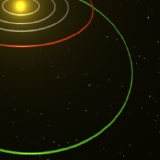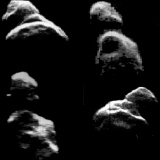| ASTEROID TOUTATIS | |||
| Since its discovery in 1989, Toutatis has turned out to be one of the strangest objects in the Solar System. Toutatis was discovered by French astronomers, who named the asteroid Toutatis after a Gaulish god. The phrase "by Toutatis" is used by Asterix and the Gauls in the Asterix books of Underzo and Goscinny. Historians do report that Gaulish soldiers used the phrase "by Toutatis". | |||
| Orbit | |||
| Toutatis makes frequent close approaches to Earth, which alters the asteroid's orbit each time. This makes it difficult to predict accurately its future orbit. Although the average distance between the Sun and Toutatis is 375 million kilometres, the high orbital eccentricity (0.64) means that perihelion is a mere 135 million kilometres. This is less than Earth's average orbital distance, and consequently Toutatis is a Near Earth Asteroid. Toutatis has the most chaotic orbit of all the NEAs. | |||
 The orbit of Toutatis. |
|||
| Toutatis is scheduled to make further close approaches to Earth: | |||
|
29th September 2004
|
1.55 million kilometres | ||
|
9th November 2008
|
7.52 million kilometres | ||
| The 2004 approach is the closest known approach of any asteroid until the year 2060. | |||
| As well as a chaotic orbit, the rotation of Toutatis on its own axis is also unusual. Toutatis has two different rotations on two different axes, one with a period of 5.4 days, the other 7.3 days. The presence of the second rotation means that Toutatis' north pole is not fixed, but follows a curved path on the asteroid. This also means that, from Toutatis, the motion of the Sun and stars would be different every "day". The orientation of Toutatis with respect to the Solar System is always unique - the orientation never repeats. The strange rotational behaviour of Toutatis is thought to be a result of a collision earlier in its history. | |||
| The orbit of Toutatis has a very low inclination with respect to the plane of Earth's orbit - less than half a degree. Combined with the chaotic and unpredictable orbit, Toutatis could one day collide with Earth. Given that Asterix and the Gauls feared only one thing - that the sky would one day fall on their heads, "by Toutatis" is most appropriate. | |||
| Physical properties | |||
| The dimensions of Toutatis were measured using radar in 1992 when Toutatis was close to Earth. The facilities used were the Arecibo radio telescope in Puerto Rico, and the Goldstone radio telescope in California. The radar results give Toutatis a diameter of 2.7 kilometres. However, radar also revealed that Toutatis also has an elongated neck, showing that Toutatis may be a "contact asteroid", that is, two smaller asteroids that have joined slowly and without destroying each other. | |||
| Double asteroids are known elsewhere, a good example being Ida Dactyl. Craters have also been found that show evidence that the impactor was a double object. The double crater shown here was formed in the Nicholson Regio part of Jupiter's moon Ganymede. | |||
 Oblong craters formed by double asteroid impact. |
|||
| Magnetic field | |||
| No magnetic field has been detected. | |||
| Interior | |||
| The interior of Toutatis is unknown, but is likely to be homogenous, that is, not layered or differentiated. | |||
| Atmosphere | |||
| No atmosphere has been detected, and Toutatis is unlikely to possess one. | |||
| Surface | |||
| Toutatis has a cratered surface with ridges, as revealed by radar studies. The craters appear to be quite shallow. Very little other detail can be seen. The albedo is calculated to be 0.18, meaning that only 18% of incident sunlight is reflected back into space - Toutatis is a dark object. | |||
 Radar image of Toutatis showing the narrow neck. |
 Time sequence of radar imagery showing Toutatis tumbling. |
||
|
|
|||